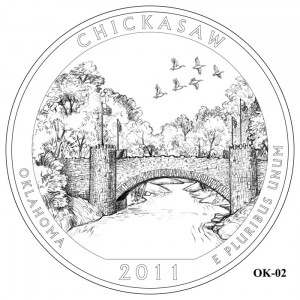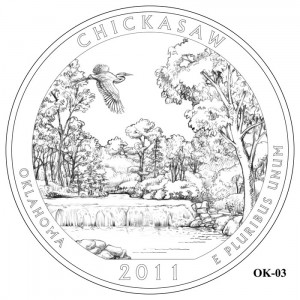The tenth issue of the America the Beautiful Silver Bullion Coin™ Program from the United States Mint and the last for the year 2011 will be the 2011 Chickasaw America the Beautiful Silver Bullion Coin. This series of bullion coins started in 2010 and runs through 2021 at a rate of five per year.
The United States Mint began offering the Chickasaw Silver Bullion Coins for sale on July 18, 2011. On that date, the Mint’s network of authorized purchasers were able to place their initial orders for the strikes. Like the previous two releases (the Olympic Silver Bullion Coin and the Vicksburg Silver Bullion Coin), demand for the Chickasaw Coin was low. Sales continued well into 2012 which is quite different from the first seven releases of the series which all sold out within weeks of their release.
The coins are all struck from five ounces of .999 fine silver to the large diameter of three inches. Inscribed on the edge of each strike will be the coins weight and fineness.
As these coins are issued as a companion series to the America the Beautiful Quarter Dollar Program, the designs seen on the obverse and reverse of the bullion coins will mimic the quarter dollars. Accordingly, a portrait of George Washington will be featured on the obverse or heads side of the coins.
The reverse or tails side will contain in image portraying a portion of Chickasaw National Recreation Area in Oklahoma. The US Mint describes the reverse of the associated quarter dollar (and thus this silver bullion coin) with:
"The Chickasaw National Recreation Area quarter design depicts the Lincoln Bridge, built of limestone and dedicated in 1909 to celebrate the centennial of Abraham Lincoln’s birth. The bridge was the first constructed improvement in the national recreation area and a favorite scenic spot. Inscriptions are CHICKASAW, OKLAHOMA, 2011 and E PLURIBUS UNUM. The reverse was designed by AIP Master Designer Donna Weaver and sculpted by United States Mint Sculptor-Engraver Jim Licaretz."
Before the final design was chosen, it was reviewed by the Commission of Fine Arts and the Citizens’ Coinage Advisory Committee. Both of these groups are given the task of critiquing possible designs for upcoming US coinage.
Comments from the CCAC and the CFA are shown below along with images of the three design candidates themselves.
The CCAC favored design number "OK-01" but added these comments:
"For the coin portraying Chickasaw National Recreation Area in Oklahoma, the committee preferred design OK-01, which features Buffalo Springs amid its stone spillway," comments the Citizen’s Coinage Advisory Committee in a letter to Treasury Secretary Timothy F. Geithner. "Members generally appreciated the perspective and composition of this design, particularly the foreground foliage. However, some members were concerned that the human figure would be so small as to be indistinct on the small scale of a coin."
The CFA did not choose any of the three submissions and explained there decision this way:
" The Commission did not recommend any of the alternatives, again commenting that the scale of the coin does not support detailed landscape depictions," wrote the CFA in a letter to Mint Director Ed Moy. "The Commission suggested further development and resubmission of the bridge featured in alternative #2 due to its distinctive form and symbolic representation of the site, while simplifying or eliminating the landscape setting."
The America’s Beautiful National Parks Quarter Dollar Coin Act of 2008 dictates that the Treasury Secretary will make the final selection after he receives the recommendation of the Mint Director, the CFA, the CCAC as well as comments from the chief executive of each host location and the Secretary of the Interior.
Up to five new strikes will appear each year from 2010 through 2021 as part of each of the America the Beautiful Quarters and Silver Bullion programs. On each coin will be a design that represents a selected National Park or National Site in each state, the District of Columbia and U.S. territories — Puerto Rico, Guam, American Samoa, the U.S. Virgin Islands and the Northern Mariana Islands.
The US Mint will not sell these bullion coins directly to the public, but instead offers them to a network of authorized purchasers who buy them in bulk. These purchasers then resell the coins in smaller lots or single units for an amount slightly above the market price of the silver contained in them to coin dealers and individuals.
The United States Mint will also be releasing a collector grade version of this coin known as the Chickasaw Silver Uncirculated Coin.
Chickasaw National Recreation Area in Oklahoma
The history of Chickasaw National Recreation Area in Oklahoma is almost as varied as the landscape which the area protects. The location gets its name from the Chickasaw Indian Nation which sold the original 640 acres to the federal government.
These Native Americans were not indigenous to this section of the country, but were relocated here in the 1830’s from the Southeastern United States. In their desire to help protect the beautiful springs, streams, and lakes scattered profusely in the area, they sold a portion of their reservation to the federal government in 1902, upon which the Sulphur Springs Reservation was created. Only a few years later, it was renamed Platt National Park in 1906.
As a national park, the area saw significant development, at least as it pertains to visitor facilities. In cooperation with the Civilian Conservation Corps (CCC) in the 1930’s, roads, trails, picnic grounds, campgrounds, dams, etc. were all created to enhance the access ability of the region.
In 1976, Platt National Park was joined by nearby Arbuckle Recreation Area and became the Chickasaw National Recreation Area we know today. Enjoyed by over a million annual visitors, boating, camping and hiking are just a few of the activities that occur within the recreation area’s boundaries.



